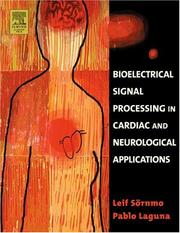| Listing 1 - 3 of 3 |
Sort by
|

ISBN: 1280337923 9786610337927 3540299319 3540256547 Year: 2005 Publisher: Berlin, Heidelberg : Springer Berlin Heidelberg : Imprint: Springer,
Abstract | Keywords | Export | Availability | Bookmark
 Loading...
Loading...Choose an application
- Reference Manager
- EndNote
- RefWorks (Direct export to RefWorks)
Facial nerve surgery inevitably leads to partial pareses, abnormally associated movements and pathologically altered reflexes. The reason for this "post-paralytic syndrome" is the misdirected reinnervation of targets, which consists of two major components. First, due to malfunctioning axonal guidance, a muscle gets reinnervated by a "foreign" axon, that has been misrouted along a "wrong" fascicle. Second, the supernumerary collateral branches emerging from all transected axons simultaneously innervate antagonistic muscles and cause severe impairment of their coordinated activity. Since it is hardly possible to influence the first major component and improve the guidance of several thousands axons, the authors concentrated on the second major component and tried to reduce the collateral axonal branching.
Nervous system --- Axons --- Nerves, Peripheral --- Facial nerve --- Muscles --- Regeneration. --- Physiology. --- Wounds and injuries. --- Innervation. --- Muscle --- Musculature --- Myodynamics --- Myology --- Musculoskeletal system --- Tissues --- Nerves, Cranial --- Nerve axons --- Neurons --- Nerve regeneration --- Nervous system regeneration --- Neural regeneration --- Neuron regeneration --- Nerve grafting --- Regeneration (Biology) --- Degeneration and regeneration --- Neurosciences. --- Neural sciences --- Neurological sciences --- Neuroscience --- Medical sciences
Book
ISBN: 2251005242 9782251005249 Year: 2005 Volume: 441 7 Publisher: Paris: Les Belles Lettres,
Abstract | Keywords | Export | Availability | Bookmark
 Loading...
Loading...Choose an application
- Reference Manager
- EndNote
- RefWorks (Direct export to RefWorks)
Anatomy --- Medicine, Greek and Roman --- Muscles --- Muscle --- Musculature --- Myodynamics --- Myology --- Musculoskeletal system --- Tissues --- Greek medicine --- Medicine, Roman --- Medicine, Unani --- Roman medicine --- Tibb (Medicine) --- Unani medicine --- Unani-Tibb (Medicine) --- Medicine, Ancient --- Medicine, Greek and Roman. --- Medicine, Greek and Roman - Early works to 1800. --- Anatomy - Early works to 1800.

ISBN: 9780124375529 0124375529 9781435608047 1435608046 1281033227 9781281033222 9786611033224 0080527922 1493301454 Year: 2005 Publisher: Boston ; Amsterdam : Elsevier Academic Press,
Abstract | Keywords | Export | Availability | Bookmark
 Loading...
Loading...Choose an application
- Reference Manager
- EndNote
- RefWorks (Direct export to RefWorks)
The analysis of bioelectrical signals continues to receive wide attention in research as well as commercially because novel signal processing techniques have helped to uncover valuable information for improved diagnosis and therapy. This book takes a unique problem-driven approach to biomedical signal processing by considering a wide range of problems in cardiac and neurological applications-the two ""heavyweight"" areas of biomedical signal processing. The interdisciplinary nature of the topic is reflected in how the text interweaves physiological issues with related methodological considerations
Electronics --- Artificial intelligence. Robotics. Simulation. Graphics --- signaalanalyse --- simulaties --- elektro-encefalografie --- medische beeldvorming --- Brain - Electric properties --- Muscles - Electric properties --- Heart - Electric properties --- Electroencephalography --- Electromyography --- Electrocardiography --- Brain --- Muscles --- Heart --- Electroencephalography. --- Electromyography. --- Electrocardiography. --- Electric properties. --- ECG --- EKG --- Electrocardiograms --- Electrodiagnosis --- Electroneuromyography --- EEG --- Encephalography --- Electrophysiology --- Visual evoked response --- Muscle --- Musculature --- Myodynamics --- Myology --- Musculoskeletal system --- Tissues --- Cerebrum --- Mind --- Central nervous system --- Head --- Diseases --- Diagnosis --- Electric properties
| Listing 1 - 3 of 3 |
Sort by
|

 Search
Search Feedback
Feedback About
About Help
Help News
News